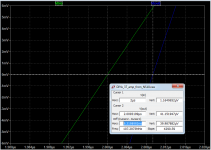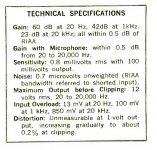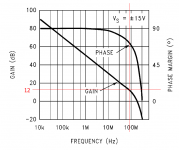If you turn Bongiorno's preamp upside down, and power it from +30V instead of -43V, you get something similar to the NS-10 preamp that Nelson Pass designed for Threshold in the late 70s.
The Threshold NS-10's product name came from the amazing fact that its signal propagation delay, from preamp input to preamp output, was ten nanoseconds: NS-10. So I thought, why not fire up the simulator and try it on the Bongiorno/NS-10 circuit in post #29? Let's measure its input-to-output prop delay.
The simulator's answer is: 9.32 nanoseconds (blue highlighted text). Well done chaps.
(you can make it faster still by decreasing the compensation capacitor C3; I've set it at 15pF which gives zero dB of gain-peaking. If you're comfortable with, oh let's just say, +2dB of gain peaking, reduce C3 and get higher bandwidth and lower propagation delay.)
_
Attachments
Last edited:
Member
Joined 2009
Paid Member
The Apex preamp isn't too complicated, you could make up a layout on strip-board. A good preamp also needs a clean supply although the Apex design does look like it would have good PSRR.
If you really want something simple, with less DIY element, then look to eBay. For example: Preamp 9 Single Ended Pure Class A 20Hz 20kHz Transistor Preamplifier Board | eBay
If you really want something simple, with less DIY element, then look to eBay. For example: Preamp 9 Single Ended Pure Class A 20Hz 20kHz Transistor Preamplifier Board | eBay
My power amp when connected directly to an ipod works fine . However the amp sounds distorted/ metallic even ipod is turned full.
Do i am assuming a small 2-4db gain preamp should do. Idea is that the amp should reach its full capacity when ipod volume is at 50%.
Wouldn't mind the controls too. Any suggestions.
Do i am assuming a small 2-4db gain preamp should do. Idea is that the amp should reach its full capacity when ipod volume is at 50%.
Wouldn't mind the controls too. Any suggestions.
Hi,(you can make it faster still by decreasing the compensation capacitor C3; I've set it at 15pF which gives zero dB of gain-peaking. If you're comfortable with, oh let's just say, +2dB of gain peaking, reduce C3 and get higher bandwidth and lower propagation delay.)
I simulated this nice circuit, and LTSpice said it can put 4V pk pk over a 10K load even at 250Khz, with minimum distortion.
Nevertheless, using exactly the same models as You (Cordell), I can t get away with less than 27p for C3, or there is gain peaking (+2dB with 15p).
Yes Mosquito you're right! At the last minute I increased the first stage's bias current to 300uA but forgot to also resize C3. Oops.
C3=15pF is sized for a 200uA first stage. To see that 15pF does indeed give 0dB of gain-peaking in that case, simulate with
I think you'll probably decide you prefer the 300uA design with resized C3.
C3=15pF is sized for a 200uA first stage. To see that 15pF does indeed give 0dB of gain-peaking in that case, simulate with
- R4 = 3K (first stage collector load resistor)
- R6 = 75K (first stage emitter bias resitor)
- R5 = R7 = 680R (feedback gain setting resistors)
I think you'll probably decide you prefer the 300uA design with resized C3.
James Bongiorno did (in 1972). Nelson Pass did (in 1977).Can I get 12 dB out of this circuit?
But today, I'd suggest you buy an LM7171 for $2.81 and do it that way instead: (link). Unless you agree with the statements
I really want a transistor based preamp. I just like the warm fuzzy sound. Chips sound shrill imho.
Attachments
Indeed.I think you'll probably decide you prefer the 300uA design with resized C3.
As for the chip, sure it can outperform the diy efforts, but are also 0 fun, as are the chip amps. Build a thingy that works correctly, and sometimes is top performer, out of discrete components, is a source of inmense satisfaction, imho...
Cheers
J.
Member
Joined 2009
Paid Member
My power amp when connected directly to an ipod works fine . However the amp sounds distorted/ metallic even ipod is turned full.
Do i am assuming a small 2-4db gain preamp should do. Idea is that the amp should reach its full capacity when ipod volume is at 50%.
Wouldn't mind the controls too. Any suggestions.
You are assuming that the ipod output distorts when running at full volume due to a limitation in the ipod. OK - do you know, but trying a different music source, if the amplifier still sounds clean at these high volumes to at least eliminate the possibility that the problem is with your amplifier and not the ipod ? could it be that you are listening to MP3 lossy-compression which will tend to show it's warts when played louder ? are you putting a big load on the ipod output but having a long cable and/or your amplifier has a relatively low input impedance ?
For 3dB of gain, it really is likely that you can adjust a couple of resistors in the feedback network of your amplifier and avoid a pre-amp altogether.
You are assuming that the ipod output distorts when running at full volume due to a limitation in the ipod. OK - do you know, but trying a different music source, if the amplifier still sounds clean at these high volumes to at least eliminate the possibility that the problem is with your amplifier and not the ipod ? could it be that you are listening to MP3 lossy-compression which will tend to show it's warts when played louder ? are you putting a big load on the ipod output but having a long cable and/or your amplifier has a relatively low input impedance ?
For 3dB of gain, it really is likely that you can adjust a couple of resistors in the feedback network of your amplifier and avoid a pre-amp altogether.
Yes, the ipod, as well as many other compact players, phones ant tablets, is intended to drive the headphones. I mean - relatively high load at relatively high volumes, comparing to driving the power amp input (low load and lower volume required). So, I'm also suspecting, the problem is not in the ipod
I might give this a go on my veroboard and see how it sounds. To get 10dB what R values should I change and anything else such as compensation caps?
R16 and R8 are responsible for setting the gain in the "Mic" mode.
Gain = R16/R8 + 1; Gain(db) = 20 log(Gain).
Right mow, it's set for around 40db.
Increasing R8 will lower it.
R8 = R16 -> Gain = 2 = 6db.
For 12db (4 times) you need R8 = 1/3 of R16.
The circuit is simple and rather low distortion for the time when it's been designed. However, nowadays, if you take TI Burr Brown's OPA627 and arrange a 2-resistor divider for a feedback - you get a top quality line stage. It does not sound. Wire with gain
Internally compensated for unity gain operation, by the way - easy to use as a buffer. I used them extensively in the line stages, subsonic filters, etc.
Expensive (local suppliers are selling then at around $20 per chip), but perfect for the purpose.
However, nowadays, if you take TI Burr Brown's OPA627 and arrange a 2-resistor divider for a feedback - you get a top quality line stage.
I agree Valery, but the OP has already stated that chips sound "shrill".
One could even take things one step farther and incorporate the 627 into the feedback loop of another VFA or CFA op-amp, lowering the distortion even more.
The OP uses the term "shrill" by comparison with older, discrete designs generally. I don't think it has any relevance to the minuscule differences between modern, audio spec. opamps.
Without knowing the OP's background, I'd take his comment about opamps in the way my father would dismiss them as being harsh, shrill etc because his experience was with crude devices, circuits and finished audio products that just weren't suitable for hi-fi.
The high cost of good opamps also means that many DIYs on low incomes will never see them in their projects anyway. Thankfully, you can at least buy genuine 5532s at low cost almost anywhere.
Without knowing the OP's background, I'd take his comment about opamps in the way my father would dismiss them as being harsh, shrill etc because his experience was with crude devices, circuits and finished audio products that just weren't suitable for hi-fi.
I think all would agree that raw tube sound is long way from hi-fi and up market audio IC reproduction.....I like raw, warm sound , like how tubes sound...
The high cost of good opamps also means that many DIYs on low incomes will never see them in their projects anyway. Thankfully, you can at least buy genuine 5532s at low cost almost anywhere.
I agree Valery, but the OP has already stated that chips sound "shrill".
One could even take things one step farther and incorporate the 627 into the feedback loop of another VFA or CFA op-amp, lowering the distortion even more.
Well, it's already so low - we can consider it's not there.
I'm sure, the OP did not try OPA627. According to the datasheet, THD 1KHz @ unity gain is 0.00003%. My measurement system, being able to measure starting from 0.0002%, does not show anything. Same as a piece of wire.
Again - at low gains it does not sound, assuming the good PSU and high-quality passive passive parts. That's what I expect from a good preamp - no influence on the signal.
Preamps from Apex, presented in post #7, are not going to influence the signal either. We discuss longer than these options can be built and tested.
One evening exercise
I prefer to pay $2.80 for the LM7171, the chip mentioned in post #47.if you take TI Burr Brown's OPA627 and arrange a 2-resistor divider for a feedback - you get a top quality line stage. It does not sound. Wire with gain ... Expensive (local suppliers are selling then at around $20 per chip), but perfect for the purpose.
If you arrange its 2-resistor feedback network to give a gain of +12dB as mentioned in post #46, the LM7171 delivers 75 MHz bandwidth and gives a phase margin greater than 60 degrees (vertical red line). For the same price as a dozen eggs.
Attachments
I'm not very attracted to the dematerialized music and I doubt that the source (iPod) to be able to feel an audible difference.....I like raw, warm sound , like how tubes sound...
I prefer to pay $2.80 for the LM7171, the chip mentioned in post #47.
If you arrange its 2-resistor feedback network to give a gain of +12dB as mentioned in post #46, the LM7171 delivers 75 MHz bandwidth and gives a phase margin greater than 60 degrees (vertical red line). For the same price as a dozen eggs.
Well ... 3 times higher noise, 10 times higher distortion, 30db lower CMRR ... requires low value resistors at the inputs ... it's a video amplifier after all.
In my opinion, NE5532 is more suitable for high quality audio applications at the lower cost, as Ian just mentioned.
I've still got 20 x OPA627 in stock, so ... no compromise approach will go on
My experience with IC op amps is that they are no easier to make than some discrete transistors. You still need a bunch of ancillary resistors bypass caps inputs outputs. I want to make a pure class A preamp. Seems if you have a class A amp, you should make a class A preamp. Is there a commercial DIP IC preamp that is class A?
Sure the easy way to guarantee an opamp runs pure class-A, is to connect an external current source between its output pin and the negative supply. The LM4562 opamp's datasheet guaranteed minimum output current is in just the right range to use a BF862 JFET as the current sink. Same is true for the OPA627. The 5532-4 don't guarantee quite as much output current, so you'll need a lower valued current source. Which you can get with a BF862 and a source degeneration resistor.
- Home
- Source & Line
- Analog Line Level
- Transistor Preamp


